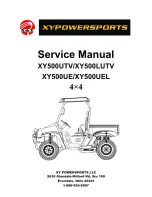
18
01-147015-00-00.fm
Safety Instructions
•
Small air bubbles can form when the radiator is filled. Therefore the cooling system must be vented at the
same time. Have this done by an authorised workshop!
Air filter
•
Danger of burns from hot parts! Do not touch any parts such as engine block, cooling system and exhaust
system during operation and for some time after. Let the engine cool down.
•
We can assume no liability for cleaned filter inserts. Never let the engine run without a filter insert!
•
Only replace the safety cartridge, do not clean it! Never let the engine run without safety cartridge!
Hydraulic system
•
Risk of injury from hydraulic oil! Hydraulic oil issuing under high pressure can penetrate the skin and cause
severe injuries. Therefore, even with the smallest wounds, consult a doctor since otherwise severe infections
can arise!
•
Danger of burns from hot parts! Do not touch any parts such as engine block, cooling system and exhaust
system during operation and for some time after. Let the engine cool down.
•
Work on the hydraulic system of the vehicle may be done only by persons with special knowledge and
experience in hydraulics.
•
Regularly check all pipes, hoses and screw connections for leaks and external visible damage. Immediately
rectify damage and leaks. Oil squirting out can cause injuries and fires. Observe the recommended
replacement intervals for hydraulic pipes. Replace hydraulic hose lines every five years from the date of
manufacture, even if they do not seem to be damaged!
•
Do not change over hydraulic pipes! Fittings and the length and quality of the hose line must comply with the
requirements.
Air conditioning system
•
Risk of injury! The coolant in the air conditioning system is under high pressure. Do not open any parts of the
air conditioning system. Have maintenance work on the air conditioning system done only by authorised
workshops.
•
Danger of burns from hot parts! Do not touch any parts such as engine block, cooling system and exhaust
system during operation and for some time after. Let the engine cool down.
Wheels
•
Risk of accident! Repair work on tyres and rims may be undertaken only by skilled personnel or authorised
workshops.
•
When changing wheels, make sure that the jack is applied to the specified jacking point.
•
Damaged tyres and/or incorrect tyre pressure reduce the operating safety of the vehicle. There is a risk of an
accident with tyres with too low or too high tyre pressure!
•
Check the wheel nuts regularly for firm seating. After a tyre change check the wheel nuts after 50 km and
tighten them if necessary.
Electrical system
•
Danger of explosion due to smoking, fire or open light! Especially when being charged, but also in the normal
use of batteries, batteries emit explosive gases! Avoid smoking, fire, sparks or open light in the vicinity of
batteries!
•
Danger of explosion due to sparks! Never place tools or other electrically conductive objects on the battery!
Sparks that can ignite escaping gases arise if the poles are short-circuited.
Always observe the correct order when connecting and disconnecting the battery!
•
Disconnecting the battery: First the minus pole and then the plus pole!
•
Connecting the battery: First the plus pole and then the minus pole!
•
Danger of explosion due to frozen battery or too low acid level! With a frozen battery or if the acid level is too
low, do not attempt to start with a jumper cable, the battery can burst or explode.
•
Danger of burns due to battery acid! The special safety and accident prevention regulations must be complied
with when handling the battery. Batteries contain sulphuric acid.
•
Work on the electrical system may be done only in accordance with electrical engineering standards by a
specialist trained for this work.
•
Regularly inspect/check the electrical equipment of the vehicle. Defects such as loose connections or
scorched cables must be removed immediately.
•
Note the operating voltage of the vehicle!
•
Use only original fuses. If stronger fuses are used, the electrical system can be destroyed and there can be
fires.
Summary of Contents for 147015
Page 23: ...01 147015 00 00 fm 23 Safety Instructions G A B D E F Fig 3 C F E C D G A A B H H C...
Page 27: ...02 147015 00 00 fm 27 Use Fig 5 24 19 25 23 22 21 20 16 18 17 10 26...
Page 31: ...02 147015 00 00 fm 31 Use Fig 7 63 64 66 65 62 68 67 56 51 52 55 54 53 59 58 60 61 57...
Page 33: ...02 147015 00 00 fm 33 Use Fig 8 74 69 76 70 72 71 77 78 79 80 81 73 75 82...
Page 97: ...04 147015 00 00 fm 97 Technical data 4 Technical data Fig 96 1270 982 3326 2269 866 1074 1200...
















































